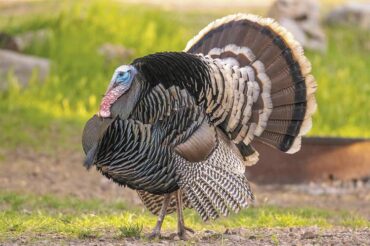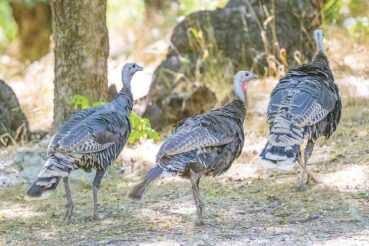James Hoagland
When you sit down to your Thanksgiving dinner this year, you might wonder where your domesticated turkey originated. We know there were wild turkeys when the pilgrims arrived, upwards of 11 million wild turkeys roamed the forests of eastern North America. How then did we go from wild turkeys to your Thanksgiving domesticated turkey dinner?
The American wild turkey’s five subspecies are unique in their own way. Most from back East are familiar with the eastern wild turkey, but here in the southern portion of Arizona and New Mexico we have a wild turkey subspecies known as the Gould’s. The other subspecies of wild turkeys are eastern wild turkey, Osceola (Florida) wild turkey, Rio Grande wild turkey, and Merriam’s wild turkey. The only other world’s turkey species is the Ocellated Turkey found in the Yucatan Peninsula. It is a gaudier tropical cousin of our wild turkey. I have seen this species in Belize.
The characteristics of our Gould’s wild turkey are long legs, light-colored tips on the tail feathers, and wings that are moderate in coloration. Adult males can weigh from 18 to 30 pounds and adult females from 8 to 12 pounds. They have moderate gobbles, beard-length and spur-lengths. If you wish to see them near us, I have spotted them at the Biosphere 2, Peppersauce Campground, and the San Pedro river crossing near San Manuel.
Did you know that Alaska is the only state in the United States that does not have wild turkeys? And did you know that Benjamin Franklin admired these “birds of courage” so much that he believed that they should be named the national bird of the U.S. instead of the bald eagle.
Turkeys usually lay between 10 to 15 eggs, but other females will put their eggs in another nest, leaving the parental behavior to the host. Incubation takes between 25 to 31 days and is done by the female. Turkeys are active during the day and sleep in trees at night to avoid predators, such as eagles, hawks, or owls.
Turkey fossils have been unearthed across the southern United States and Mexico, some of them dating from more than 5 million years ago.
So where did the domesticated turkey come from? Domestic turkey come from the wild turkey (Meleagris gallopavo), a species that is native only to the Americas. In the 1500s, Spanish traders took some that had been domesticated by Indigenous Americans to Europe and Asia. The bird reportedly got its common name because it reached European tables through shipping routes that passed through the Republic of Türkiye. On a continent where fine dining still included eating storks, herons, and bustards, the meaty, succulent turkey was a sensation.
Later on, when English settlers came to America, they brought turkeys with them, but they were amazed to find the same birds running wild and free, and tasting really good thanks to their natural diet of chestnuts, beechnuts, walnuts, and other native mast.
So, this Thanksgiving thank the wild turkey for your domesticated turkey dinner.


